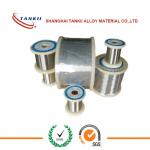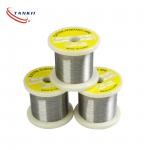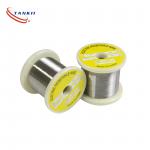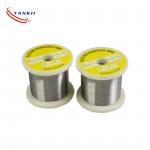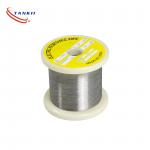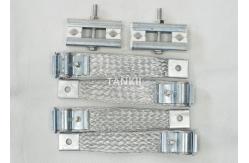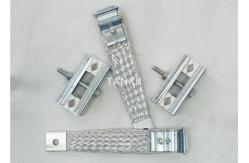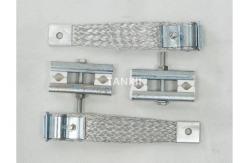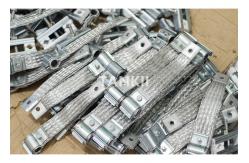Accustomized Size Clamp for Silicon Carbon Bar Element Application
Properties
The advantageous properties of stainless steels can be seen when
compared to standard plain carbon mild steel. Although stainless
steels have a broad range of properties, in general, when compared
with mild steel, stainless steels have:
~ Higher corrosion resistance
~ Higher cryogenic toughness
~ Higher work hardening rate
~ Higher hot strength
~ Higher ductility
~ Higher strength and hardness
~ A more attractive appearance
~ Lower maintenance
Corrosion Resistance
All stainless steels are iron-based alloys that contain a minimum
of around 10.5% Chromium. The Chromium in the alloy forms a
self-healing protective clear oxide layer. This oxide layer gives
stainless steels their corrosion resistance. The self healing
nature of the oxide layer means the corrosion resistance remains
intact regardless of fabrication methods. Even if the material
surface is cut or damaged, it will self heal and corrosion
resistance will be maintained.
Conversely, normal carbon steels may be protected from corrosion by
painting or other coatings like galvanising. Any modification of
the surface exposes the underlying steel and corrosion can occur.
The corrosion of different grades of stainless steel will differ
with various environments. Suitable grades will depend upon the
service environment. Even trace amounts of some elements can
markedly alter the corrosion resistance. Chlorides in particular
can have an adverse effect on the corrosion resistance of stainless
steel.
Grades high in Chromium, Molybdenum and Nickel are the most
resistant to corrosion.
| ITEM | Stainless Steel Wire |
| BRAND | RONSCO,BAOSTEEL, JISCO, TISCO, etc. |
| MATERIAL | 200,300 and 400 SERIES |
| STANDARD | GB, AISI, ASTM, ASME, EN, BS, DIN, JIS |
| CERTIFICATE | CE,BV,SGS |
| SURFACE | electrolysis bright, bright, matt. |
| APPLICATION | Construction and decoration, as well as all kinds of industries
and manufacture |
| PACKING | Standard export sea-worthy packing |
| SHIPMENT | Ocean shipping |
| LEAD TIME | 3-15 days after deposit |
| PAYMENT | T/T, L/C, Western Union |
Cryogenic (Low Temperature) Resistance
Cryogenic resistance is measured by the ductility or toughness at
sub zero temperatures. At cryogenic temperatures the tensile
strengths of austenitic stainless steels are substantially higher
than at ambient temperatures. They also maintain excellent
toughness.
Ferritic, martensitic and precipitation hardening steels should not
be used at sub-zero temperatures. The toughness of these grades
drops significantly at low temperatures. In some cases this drop
occurs close to room temperature.
Work Hardening
Work hardenable grades of stainless steel have the advantage that
significant increases to the strength of the metal can be achieved
simply through cold working. A combination of cold working and
annealing stages can be employed to give the fabricated component a
specific strength.
A typical example of this is the drawing of wire. Wire to be used
as springs will be work hardened to a particular tensile strength.
If the same wire was to be used as a bendable tie wire, it would be
annealed, resulting in a softer material.
Hot Strength
Austenitic grades retain high strength at elevated temperatures.
This is particularly so with grades containing high levels of
chromium and/or high silicon, nitrogen and rare earth elements
(e.g. grade 310 and S30815). High chromium ferritic grades like 446
can also show high hot strength.
The high chromium content of stainless steels also helps to resist
scaling at elevated temperatures.
Properties
The advantageous properties of stainless steels can be seen when
compared to standard plain carbon mild steel. Although stainless
steels have a broad range of properties, in general, when compared
with mild steel, stainless steels have:
~ Higher corrosion resistance
~ Higher cryogenic toughness
~ Higher work hardening rate
~ Higher hot strength
~ Higher ductility
~ Higher strength and hardness
~ A more attractive appearance
~ Lower maintenance
Corrosion Resistance
All stainless steels are iron-based alloys that contain a minimum
of around 10.5% Chromium. The Chromium in the alloy forms a
self-healing protective clear oxide layer. This oxide layer gives
stainless steels their corrosion resistance. The self healing
nature of the oxide layer means the corrosion resistance remains
intact regardless of fabrication methods. Even if the material
surface is cut or damaged, it will self heal and corrosion
resistance will be maintained.
Conversely, normal carbon steels may be protected from corrosion by
painting or other coatings like galvanising. Any modification of
the surface exposes the underlying steel and corrosion can occur.
The corrosion of different grades of stainless steel will differ
with various environments. Suitable grades will depend upon the
service environment. Even trace amounts of some elements can
markedly alter the corrosion resistance. Chlorides in particular
can have an adverse effect on the corrosion resistance of stainless
steel.
Grades high in Chromium, Molybdenum and Nickel are the most
resistant to corrosion.
Cryogenic (Low Temperature) Resistance
Cryogenic resistance is measured by the ductility or toughness at
sub zero temperatures. At cryogenic temperatures the tensile
strengths of austenitic stainless steels are substantially higher
than at ambient temperatures. They also maintain excellent
toughness.
Ferritic, martensitic and precipitation hardening steels should not
be used at sub-zero temperatures. The toughness of these grades
drops significantly at low temperatures. In some cases this drop
occurs close to room temperature.
Work Hardening
Work hardenable grades of stainless steel have the advantage that
significant increases to the strength of the metal can be achieved
simply through cold working. A combination of cold working and
annealing stages can be employed to give the fabricated component a
specific strength.
A typical example of this is the drawing of wire. Wire to be used
as springs will be work hardened to a particular tensile strength.
If the same wire was to be used as a bendable tie wire, it would be
annealed, resulting in a softer material.
Hot Strength
Austenitic grades retain high strength at elevated temperatures.
This is particularly so with grades containing high levels of
chromium and/or high silicon, nitrogen and rare earth elements
(e.g. grade 310 and S30815). High chromium ferritic grades like 446
can also show high hot strength.
The high chromium content of stainless steels also helps to resist
scaling at elevated temperatures.
